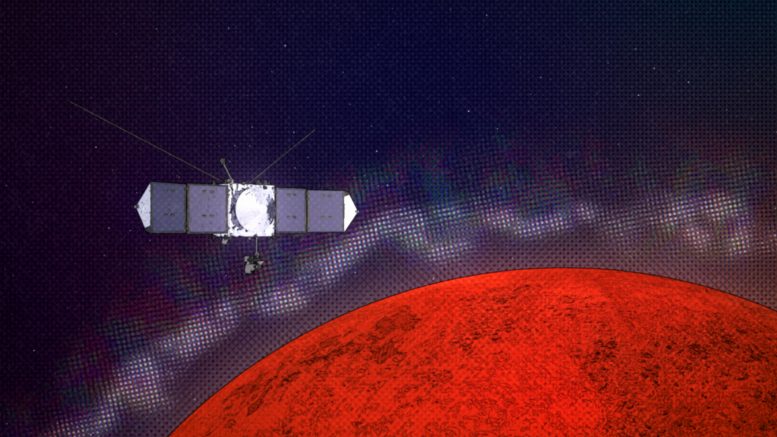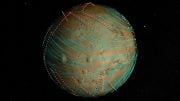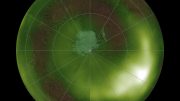
Graphic illustrating radio signals from a remote station (bent purple line) interfering with a local station (black tower) after being reflected off a plasma layer in the ionosphere. Credit: NASA Goddard/CI lab
NASA’s MAVEN (Mars Atmosphere and Volatile EvolutioN) spacecraft has discovered “layers” and “rifts” in the electrically charged part of the upper atmosphere (the ionosphere) of Mars. The phenomenon is very common on Earth and causes unpredictable disruptions to radio communications. However, we do not fully understand them because they form at altitudes that are very difficult to explore on Earth. The unexpected discovery by MAVEN shows that Mars is a unique laboratory to explore and better understand this highly disruptive phenomenon.
NASA’s MAVEN (Mars Atmosphere and Volatile Evolution) spacecraft has discovered “layers” and “rifts” in the electrically charged part of the upper atmosphere (the ionosphere) of Mars. The phenomenon is very common at Earth and causes unpredictable disruptions to radio communications. However, we do not fully understand them because they form at altitudes that are very difficult to explore at Earth. The unexpected discovery by MAVEN shows that Mars is a unique laboratory to explore and better understand this highly disruptive phenomenon. Credit: NASA’s Goddard Space Flight Center
“The layers are so close above all our heads at Earth, and can be detected by anyone with a radio, but they are still quite mysterious,” says Glyn Collinson of NASA’s Goddard Space Flight Center in Greenbelt, Maryland, lead author of a paper on this research appearing February 3, 2020, in Nature Astronomy. “Who would have thought one of the best ways to understand them is to launch a satellite 300 million miles to Mars?”
If your favorite radio station has ever jammed or been replaced by another station, a likely cause are layers of electrically charged gas, called “plasma”, in the very upper-most region of the atmosphere, called the “ionosphere”. Forming suddenly and lasting for several hours, these layers act like giant mirrors in the sky, causing radio signals from far away to bounce over the horizon where they can interfere with local transmissions, like two people trying to talk over one another. The layers also can cause interference with radio communications by aircraft and shipping, and can blind military radar.
At Earth, the layers form at an altitude of about 60 miles (approximately 100km) where the air is too thin for an aircraft to fly, but too thick for any satellite to orbit. The only way to reach them is with a rocket, but these missions last only tens of minutes before falling back to Earth. “We’ve known they exist for over 80 years, but we know so little about what goes on inside them, because no satellite can get low enough to reach the layers,” says Collinson, “at least, no satellite at Earth.”

Graphic illustrating the MAVEN spacecraft encountering plasma layers at Mars. Credit: NASA Goddard/CI lab
At Mars, spacecraft such as MAVEN can orbit at lower altitudes and can sample these features directly. MAVEN carries several scientific instruments that measure plasmas in the atmosphere and space around Mars. Recent measurements from one of these instruments detected unexpected sudden spikes in the abundance of plasma as it flew through the Martian ionosphere. Joe Grebowsky, the former MAVEN project scientist at NASA Goddard, immediately recognized the spike from his previous experience with rocket flights through the layers at Earth. Not only had MAVEN discovered that such layers can occur at other planets than Earth, but the new results reveal that Mars offers what Earth cannot, a place where we can reliably explore these layers with satellites.
“The low altitudes observable by MAVEN will fill in a great gap in our understanding of this region on both Mars and Earth, with really significant discoveries to be had,” says Grebowsky, a co-author on the paper.
MAVEN observations are already overturning many of our existing ideas about the phenomena: MAVEN has discovered that the layers also have a mirror-opposite, a “rift”, where plasma is less abundant. The existence of such “rifts” in nature was completely unknown before their discovery at Mars by MAVEN, and overturns existing scientific models which say they cannot form. Additionally, unlike at Earth where the layers are short-lived and unpredictable, the Martian layers are surprisingly long-lived and persistent.
These new discoveries already have given us a better understanding of the fundamental processes that underpin these layers, and future exploration at Mars will allow us to build better scientific models of how they form. While, much like the weather, we cannot stop them from forming, perhaps someday the new insights from Mars may help us to forecast them at Earth, meaning more reliable radio communication for us all.
Reference: “Constantly forming sporadic E-like layers and rifts in the Martian ionosphere and their implications for Earth” by Glyn A. Collinson, James McFadden, Joseph Grebowsky, David Mitchell, Rob Lillis, Paul Withers, Marissa F. Vogt, Mehdi Benna, Jared Espley and Bruce Jakosky, 3 February 2020, Nature Astronomy.
DOI: 10.1038/s41550-019-0984-8
This research was funded by the MAVEN mission. MAVEN’s principal investigator is based at the University of Colorado’s Laboratory for Atmospheric and Space Physics, and NASA’s Goddard Space Flight Center in Greenbelt, Maryland, manages the MAVEN project. Partner institutions include Lockheed Martin, the University of California at Berkeley, and NASA’s Jet Propulsion Laboratory. NASA is exploring our Solar System and beyond, uncovering worlds, stars, and cosmic mysteries near and far with our powerful fleet of space and ground-based missions.








This article overstates the role of reflected radio waves from the various layers of air in Earth’s ionosphere. We have known about the ionosphere since Marconi’s day. The entire short wave broadcasting industry has relied upon a well understood ionosphere for many years. There may or not be an ionosphere around Mars but to suggest that discovering it explains Earth’s ionosphere is ridiculous. Amateur radio operators have thousand of contacts every day using the several ionized air layers. This article is simply a space filling use of verbiage to inform readers of something already well known.
I think the gist of the article is that we can better explore the martian ionosphere than the Earth’s because satellites can orbit lower around Mars. As the article points out, we have discovered rifts (Quote: “The existence of such “rifts” in nature was completely unknown before their discovery at Mars by MAVEN, and overturns existing scientific models which say they cannot form”) and changed our understanding of the Earth’s own ionosphere. It’s not about the reflection of radio waves per se. The article starts with that because not many readers may be acquainted with the phenomenon, I assume.